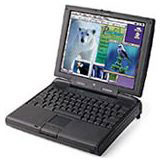The PowerBook 3400c was released
on February 17, 1997. It featured a 180, 200, or 240 MHz PowerPC
603e processor  and cost over US$4,500. It
came with a 6x or 12x CD-ROM drive, featured a 1.3 GB or 2 GB
hard disk, and came with System 7.6 preinstalled. The case design
was essentially an extension of the 5300 design, made to fit the 3400c's 12.1"
screen.
and cost over US$4,500. It
came with a 6x or 12x CD-ROM drive, featured a 1.3 GB or 2 GB
hard disk, and came with System 7.6 preinstalled. The case design
was essentially an extension of the 5300 design, made to fit the 3400c's 12.1"
screen.
The 3400 performed well and was considered the fastest notebook
computer available for a few months, but it was quickly replaced by
the PowerBook G3 (sometimes known as
the 3500), which shipped in an almost identical case with a 250 MHz
PowerPC G3 processor, 32 MB of RAM, and a 5 GB hard disk. It
featured hot swappable drive bays, and four speakers, selling for a
hefty US$5,700.
The 3500 had a high price and a short life; the PowerBook G3 Series replaced it in 1998.
This model was also known as the "WallStreet" G3. The base (233
MHz) model is sometimes referred to as the "MainStreet;" it uses a
G3 chip like the others, but it has no level 2 cache, which meant
that it's performance was less than might be expected for a G3.
There were several models of WallStreet PowerBooks. The base
model had a 12.1" screen, a 233 MHz G3 processor (without a
backside cache), 32 MB of RAM, and a 2 GB hard disk. The next
model up had a 266 MHz G3 with a 13.3" screen, 32 MB of RAM, and a
4 GB hard disk. The high-end model has a 292 MHz G3 with a
14.1" screen, 32 MB of RAM, and a 6 GB hard drive. You could
order your PowerBook from Apple in custom configurations as
well.
The 3400c was an extension of the 5300 series design, made to be
able to accept the 12.1" screen. The 3400 is almost twice as fast
as the 1400 (performance will be
similar to the desktop Power Mac 6400
series), which is not bad performance for an older laptop. The 3400
can be a good choice for those users who would like a decent laptop
computer and don't want to spend a lot of money. The 3400
frequently sells on eBay
for less than $300. As with the 5300 and 1400, if you are looking
for one of these, make sure you get one with the amount of RAM you
want already installed, since RAM is expensive for the 3400c.
Unfortunately the 3400c is not G3 upgradeable like the 1400 (which
explains the low price), so if you think you will need a G3,
consider buying either a PowerBook G3 or a 1400 with a G3
upgrade.
The 3500/G3 is relatively rare these days. Because of the high
original price many people did not decide to purchase one. However,
if you find one now, its price is most likely going to be low,
mainly because this PowerBook G3 is the only G3 not supported under
Mac OS X. Since the 3500/G3 was basically a 3400c with a G3
processor, Mac OS X does not support some of the older parts
that are in these machines. If you don't plan to run OS X,
these machines are great. The G3 inside gives decent performance,
and the four-speaker system sounds excellent.
The WallStreet PowerBook G3 was the first PowerBook to offer a
14.1" screen. WallStreet PowerBooks are OS X compatible, and
also have a full compliment of legacy ports (ADB, serial, SCSI).
They also give you two PCMCIA card slots, just like the 3400c and
3500, so you can use modern USB cards. The only major drawback to
the Wallstreet series is the size and weight. They are large and
heavy - but the price may make up for some of that. You can often
find them for less than $800 on eBay.
Make sure you stay away from the cacheless G3/233 model unless you
don't mind buying a G3 with less than G3 performance; the speed of
that compares better to a 6500/225
than it does to a G3/233.
Look around for deals on eBay. Lately I have seen some pretty
nice machines go up for auction. If you use Internet Explorer 5.0
or 5.1 for OS X, you can even watch an auction so that you can
bid on it if you are outbid. As OS X becomes more widely used,
the older non-OS X compatible machines and early G3s will be
retired - and they will sell for less than they are selling for
now.
If you plan to run OS X in the field, you may consider
something slightly faster. We'll look at the PowerBook G3 "Lombard" and PowerBook G3 "Pismo" models in another
article.

 and cost over US$4,500. It
came with a 6x or 12x CD-ROM drive, featured a 1.3 GB or 2 GB
hard disk, and came with System 7.6 preinstalled. The case design
was essentially an extension of the
and cost over US$4,500. It
came with a 6x or 12x CD-ROM drive, featured a 1.3 GB or 2 GB
hard disk, and came with System 7.6 preinstalled. The case design
was essentially an extension of the 
